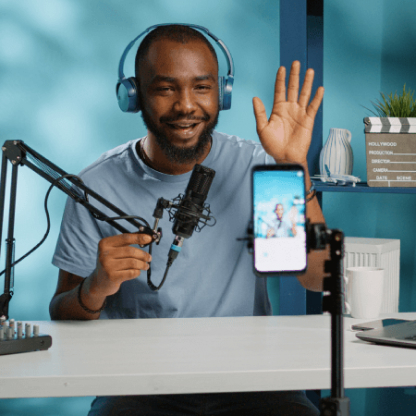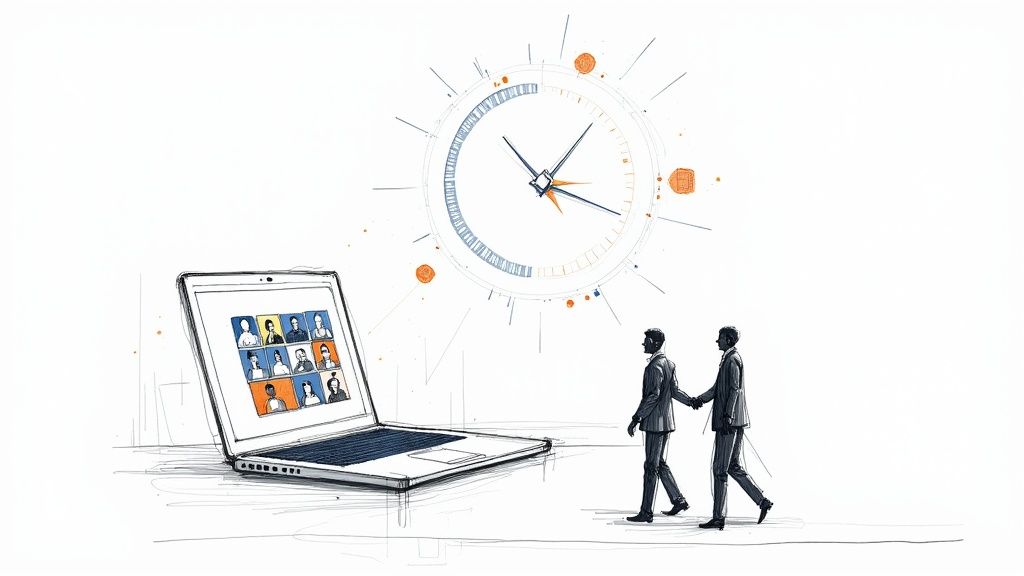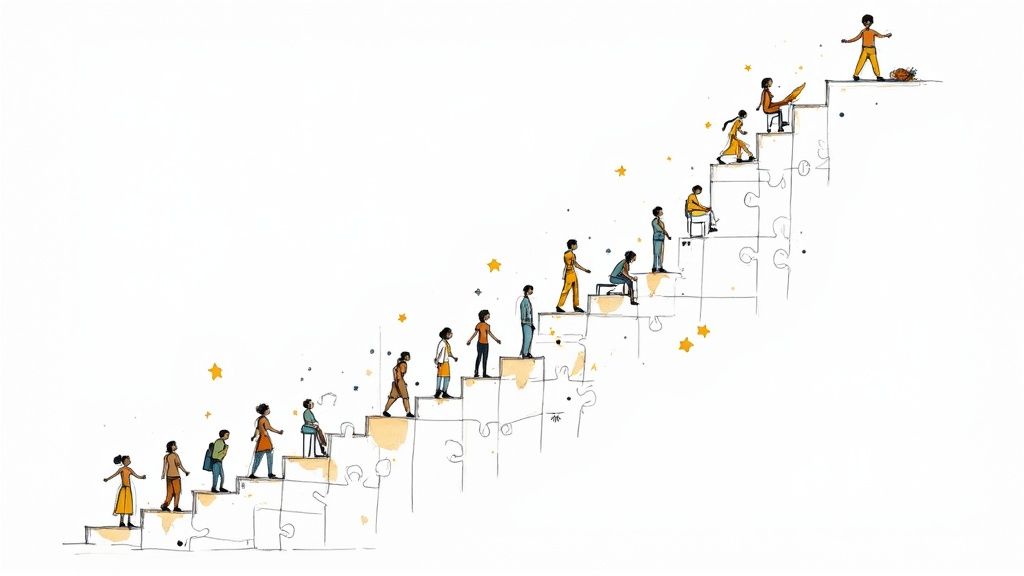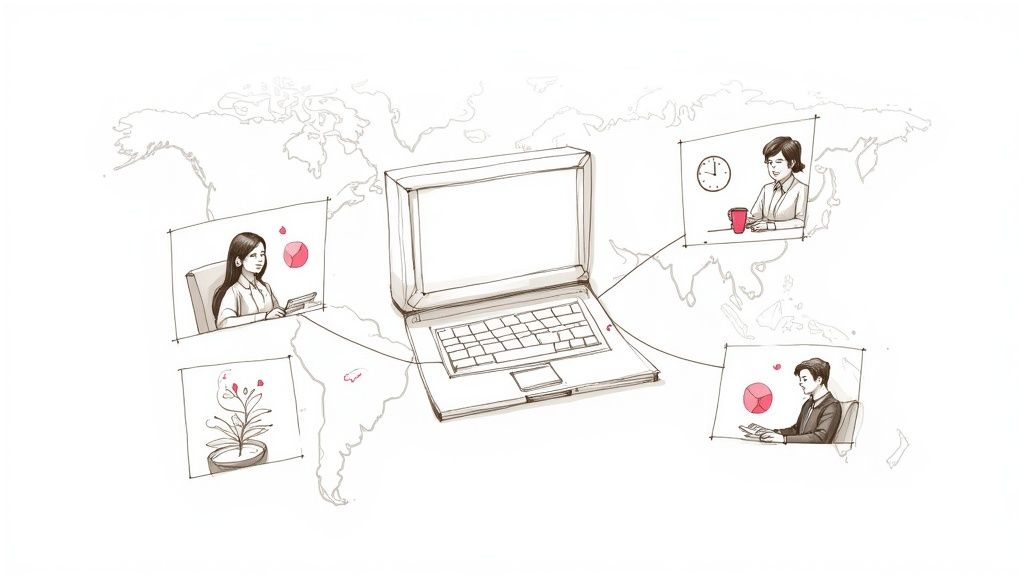Let's cut to the chase: your video interview outfit is the first thing they'll judge you on. And they will judge you.
If you want the quickest, safest answer, here it is: dress one level above the company's daily dress code. Simple. This move instantly shows respect and proves you take the opportunity seriously, even if you're just dialing in from your living room. Done.
Your Outfit Is Your Non-Verbal Handshake
Before you even say "hello," the interviewer has already formed a snap judgment. Is this person professional? Do they have their act together? Think of your outfit as your first impression—a non-verbal handshake that sets the tone for the entire conversation.
I’ve seen brilliant candidates torpedo their own chances simply because they showed up looking like they just rolled out of bed. This isn't about being a fashion expert; it's about understanding perception. It’s about giving yourself a powerful psychological edge before you've even uttered a word.
Frankly, just hoping they’ll focus on your resume is a rookie move. The reality is, how you present yourself matters. A lot. A major career platform survey revealed that nearly 75% of hiring managers believe candidates who dress professionally for video calls are significantly more likely to advance.
Even more telling? A staggering 84% of them admit a candidate's appearance influences their perception of professionalism. The data doesn't lie.
This isn't just my opinion after years in the hiring trenches. The numbers consistently draw a direct line between what you wear and how you're perceived—and just as importantly, how you feel.
The infographic below breaks it down. Toot, toot!
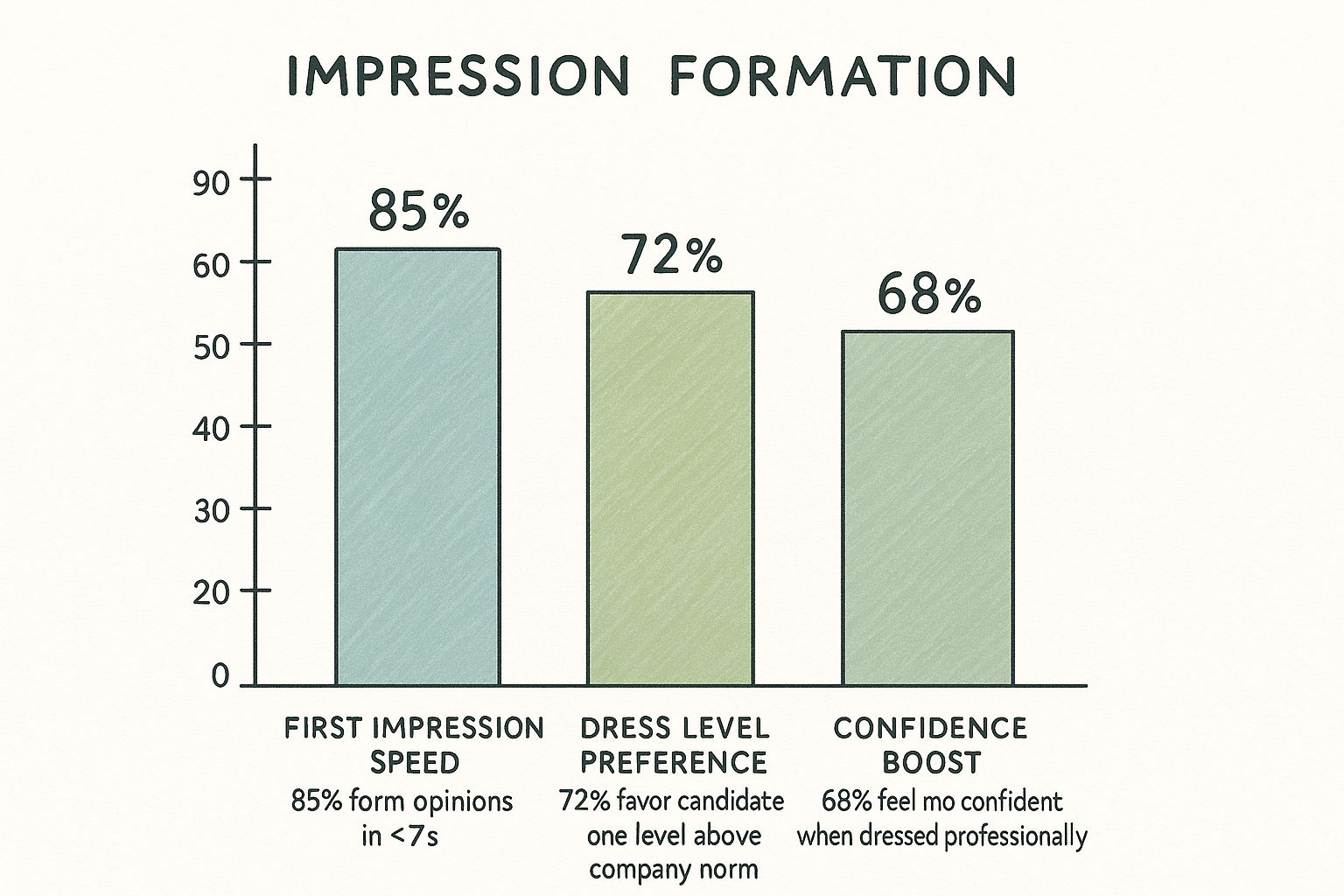
The takeaway here is crystal clear. Dressing professionally doesn't just influence the interviewer; it gives you a measurable advantage by boosting your own confidence when it matters most.
Understanding the psychology of dressing like you've already made it can also powerfully signal that you're competent and ready for the role.
Of course, your outfit is just one piece of the puzzle. To make sure you've covered all your bases, check out our complete guide on https://asyncinterview.io/post/how-to-prepare-for-a-video-interview/.
Choosing Colors That Work On Camera
Here's a hard truth I've learned from watching hundreds, if not thousands, of video interviews: your favorite shirt might look terrible on camera. Seriously. The wrong color can wash you out, reflect weird light, or just plain distract from what you’re saying. We’re not talking about art school color theory here; this is the practical science of pixels.
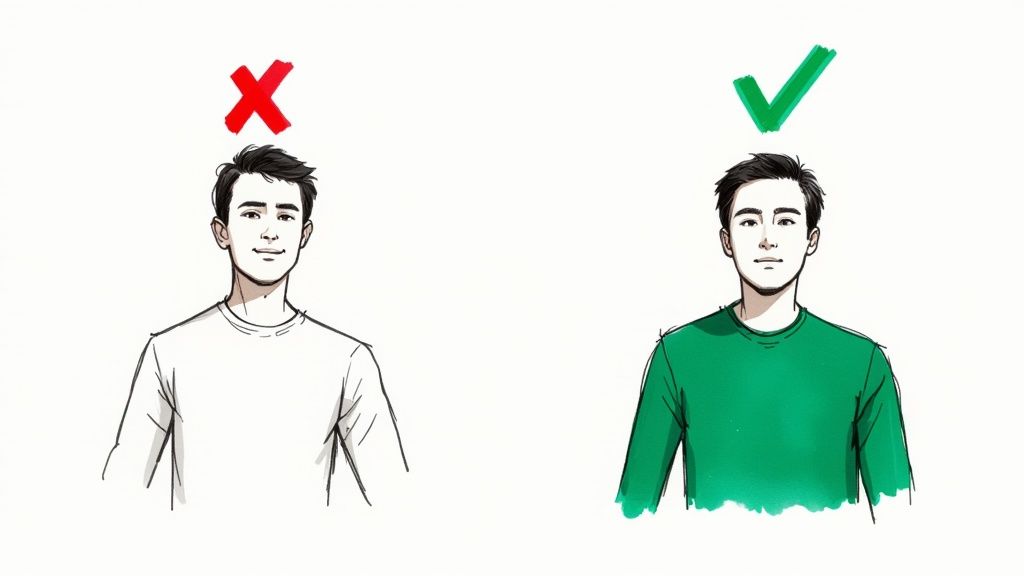
Think of your webcam as a dumb, unforgiving eyeball. It hates extremes. Bright whites "bloom" on camera, creating a distracting glare that makes it hard for the interviewer to actually see your face. On the flip side, jet black can crush all the detail, making you look like a floating head in a dark void. Not a great look.
So, what's the sweet spot?
Finding Your On-Screen Power Colors
Your best bet is to stick with solid colors—specifically jewel tones and muted neutrals. I've found these consistently translate best through a lens. After countless video calls, I can tell you what works.
Here are the safest, most effective choices:
- Navy Blue: It projects authority and trustworthiness without being as harsh as pure black. My personal go-to.
- Emerald Green: This color is rich and confident, popping just enough on screen without being overwhelming.
- Burgundy or Maroon: A strong, professional choice that brings a little warmth to the screen.
- Charcoal Gray: This is a fantastic, softer alternative to black that still looks sharp and modern.
These colors provide great contrast against most common backgrounds, making you the clear focal point. That’s exactly where you want to be.
The Cardinal Sin of Video Interviews: Never, ever wear a color that’s too close to your background. Unless you’re trying out for a role as a disembodied voice, you want to avoid becoming a floating head in a sea of beige.
The Data Backs It Up
This isn’t just my personal preference from years of hiring. Research shows that 68% of interviewers felt candidates wearing solid, neutral colors appeared more credible and professional. Conversely, candidates who blended into their background were often perceived as less engaged or "washed out." If you want to dive deeper, you can explore more insights on video interview attire.
Finally, a quick word on patterns: just say no. Busy patterns like tight stripes, small checks, or houndstooth can create a bizarre, shimmering effect on camera called moiré. It’s incredibly distracting and makes you look like a walking optical illusion. When in doubt, always keep it solid, simple, and professional.
Dress for the Job Not for the Couch
The biggest lie we tell ourselves about remote work is that comfort is king. Let me be blunt: for a video interview, confidence is king, and dressing the part is what fuels it. You can have the most polished resume on the planet, but if you show up in a hoodie, you’re subconsciously telling the interviewer you aren’t taking this seriously.
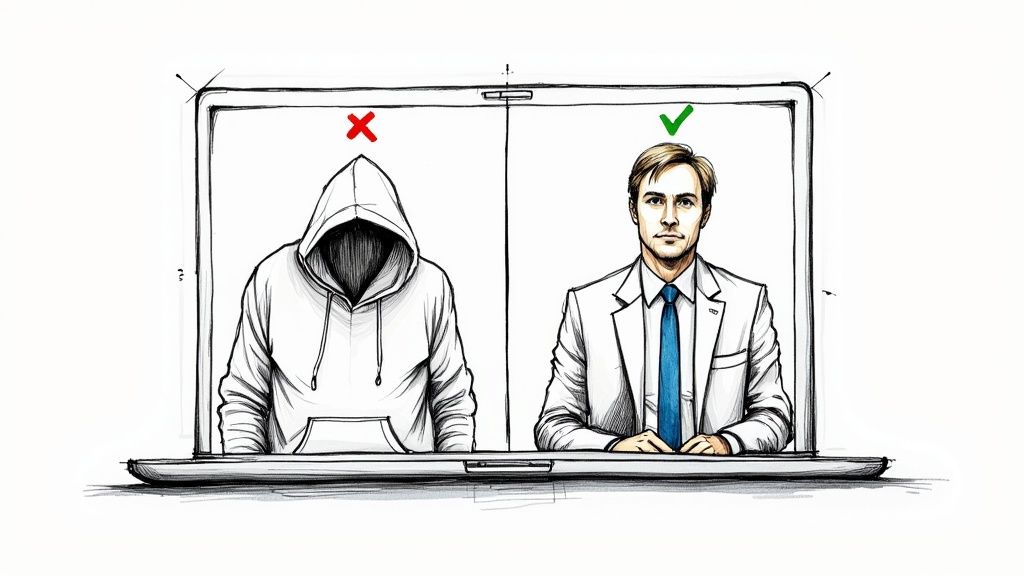
I’ve interviewed hundreds of people, and the difference in energy between someone in a blazer versus a faded t-shirt is palpable. It’s not about being stuffy; it’s about a psychological phenomenon called "enclothed cognition."
The short version? What you wear directly impacts how you think, feel, and perform. When you dress for the job, you act like you already have it. It's that simple.
Business Formal vs. Business Casual: The Great Debate
So, what’s the right call? A full suit or a sharp sweater? The answer is simple: it depends entirely on the company culture you’re trying to join. Showing up in a three-piece suit for a tech startup interview is just as awkward as wearing a polo to interview with a top-tier law firm.
Don't guess. The goal isn't just to look good; it's to look like you belong there. A few minutes of research is the difference between looking prepared and looking completely out of touch.
Global workplace trends show this divide is very real. In North America and Europe, 58% of companies in finance and law still expect formalwear, while in the tech sector, that number plummets to just 29%.
The real kicker? A solid 63% of candidates report higher confidence when dressed professionally from head to toe—even the parts the camera can’t see. To me, that’s not just a stat; it’s a competitive advantage. You can explore more on the psychology of dressing for success if you're curious.
So how do you figure out a company's dress code without asking? It's easier than you think.
- Scour their social media: Look at the company’s LinkedIn or Instagram. How are employees dressed in group shots or at company events?
- Check their 'About Us' page: Team photos are a goldmine of information. Are they in collared shirts or branded hoodies?
- Look up the interviewer: A quick LinkedIn search on the person interviewing you can often reveal their professional style.
Once you have a baseline, remember the golden rule: dress one level above their daily standard. It’s the simplest way to show respect for their time and the opportunity. This is about showing up prepared to win the job, not just to have a chat.
Avoid These Common Rookie Mistakes
Alright, let's get one of the biggest myths of remote interviews out of the way: the "business on top, party on the bottom" approach. We've all heard it—a crisp, professional shirt paired with pajama pants just out of frame. It sounds efficient, right? Wrong. It’s a disaster waiting to happen.
I’ve heard absolute horror stories that prove this is a terrible, terrible idea. From a dog knocking over a laptop to a candidate having to stand up unexpectedly to grab a document, this shortcut can lead to instant regret. Don't do it.
Think of dressing the part, completely, as a small integrity test. If you’re cutting corners on your pants, what other corners might you be tempted to cut? A wrinkled shirt can scream, "I don't own an iron, and my attention to detail is questionable." This section is your pre-flight checklist to avoid total, cringeworthy embarrassment.
The Little Things That Cause Big Problems
I’ve seen fantastic candidates get sidelined by mistakes that were so easy to avoid. It’s not just about what shirt you pick; it's the entire package you present on screen. A great outfit on an unkempt person is a completely wasted effort.
Here are the top offenders I see time and time again:
- Distracting Jewelry: That shiny necklace might look incredible in person, but on camera, it can catch the light and become a distracting flare every time you move. Keep your accessories minimal and non-reflective.
- Poor Grooming: A perfectly chosen blazer means nothing if your hair is a mess or you look like you just rolled out of bed. Take five minutes to look polished. It signals you’re taking this opportunity seriously.
- The Full-Outfit Fail: Just wear the pants. Seriously. The peace of mind alone is worth it, but there's more to it. Psychologically, dressing in a complete, professional outfit actually boosts your confidence and helps you perform better.
The goal is to be memorable for your brilliant answers, not for the laundry pile in your background or the wrinkled collar that screams you pulled your shirt from the bottom of a hamper.
Ultimately, avoiding these slip-ups is about controlling the narrative. You want the focus squarely on your skills, your experience, and why you're the best fit for the role.
For a deeper dive into crafting a flawless virtual presence, our guide on virtual interview tips covers everything from your tech setup to your final sign-off. Don't leave anything to chance.
Your Background Is Part of Your Outfit
You wouldn't show up to an in-person interview with a massive coffee stain on your tie, right? So why would you hop on a video call in front of a messy bedroom? Let’s be crystal clear about this: your background is a direct extension of your professional self.
A cluttered, distracting backdrop completely torpedoes even the most perfectly chosen outfit. I've seen it happen.
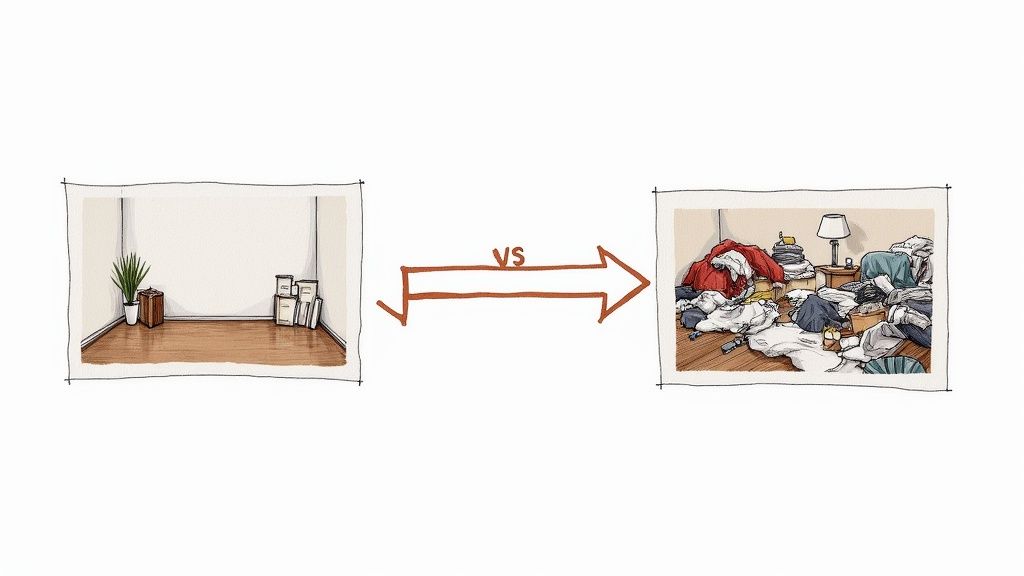
This isn’t about needing a degree in interior design. It's about controlling the narrative. You want the interviewer focused on your brilliant answers, not the questionable pile of laundry behind you or your roommate who just photobombed your big moment.
Staging Your Space for Success
First things first: ditch the blurry virtual backgrounds. They often look cheap, glitchy, and can make it seem like you have something to hide. A real, thoughtfully arranged space shows confidence and a serious attention to detail.
Here’s a no-nonsense checklist to get it right:
- Find Your Light: Face a window or a soft light source. Backlighting—where the light is behind you—turns you into a shadowy silhouette. Great for witness protection, terrible for an interview.
- Declutter Like You Mean It: Get rid of anything that doesn't scream "professional." This means stray coffee mugs, stacks of mail, and anything else that looks like it belongs in a college dorm room.
- Add a Touch of Personality: Think strategically. A neatly organized bookshelf, a healthy plant, or a single piece of tasteful art can add some character without being a distraction.
Treat your interview space like a stage. Some of the same principles that apply when preparing a home for sale can help you make a powerful first impression. In fact, checking out some expert real estate staging tips can give you some great ideas to maximize your space’s appeal.
Ultimately, your environment sends a powerful message. It shows you’re organized, thoughtful, and prepared your entire presentation—not just your shirt.
For more on the technical side of things, our guide on how to record a video interview will help you nail the complete setup.
Got Questions About Video Interview Outfits? Let's Talk.
Alright, let's tackle those questions I know are buzzing in your head. I've heard them all over the years, and my goal is to give you straight, no-fluff answers so you can stop stressing about your closet and start focusing on your interview.
Can I Get Away with Wearing a T-shirt?
Let me be blunt: almost never. Even if you're interviewing for the most laid-back startup with a ping-pong table in the breakroom, a t-shirt is a huge gamble. The absolute bare minimum would be a high-quality, plain tee layered under a sharp blazer.
Showing up in just a t-shirt, no matter how cool, sends one message: you didn't think this was important enough to make an effort. The risk of looking unprofessional is massive, and for what? To look "chill"? It's a bad trade.
Trust me on this one. It's always, always better to be slightly overdressed than to be remembered for your graphic tee.
Do I Really Need to Bother with Makeup or Hair?
Yes, but don't overthink it. You're not getting ready for a night out; you're aiming for a polished, intentional look.
Webcams have a nasty habit of washing people out, making even the most well-rested person look a bit flat or tired. A little effort here makes a surprisingly big difference.
- For your hair: Just make sure it's neat and, most importantly, out of your face. The last thing you want is to be fidgeting with stray strands the entire call.
- For makeup: A natural look is key. Even a little color on your cheeks or lips can bring some life back to your face on screen, making you appear more vibrant and engaged.
What if the Company Culture Is Super Informal?
So you've done your homework and discovered the team basically lives in hoodies and jeans. That's great info to have. But it doesn't mean you should show up that way.
Interview-casual is a totally different beast than Tuesday-afternoon-casual. A full suit is definitely overkill in this scenario, but you still need to show respect for the process.
A clean, collared shirt (think a nice polo or an Oxford), a simple sweater, or a professional blouse is a perfect, safe bet. Just steer clear of anything with huge logos or loud graphics. You want them focused on your brilliant answers, not your outfit.
Ready to stop sorting through applicants and start meeting your top candidates? Async Interview streamlines your initial screening process, letting you hire up to ten times faster. See how it works at https://asyncinterview.io.
